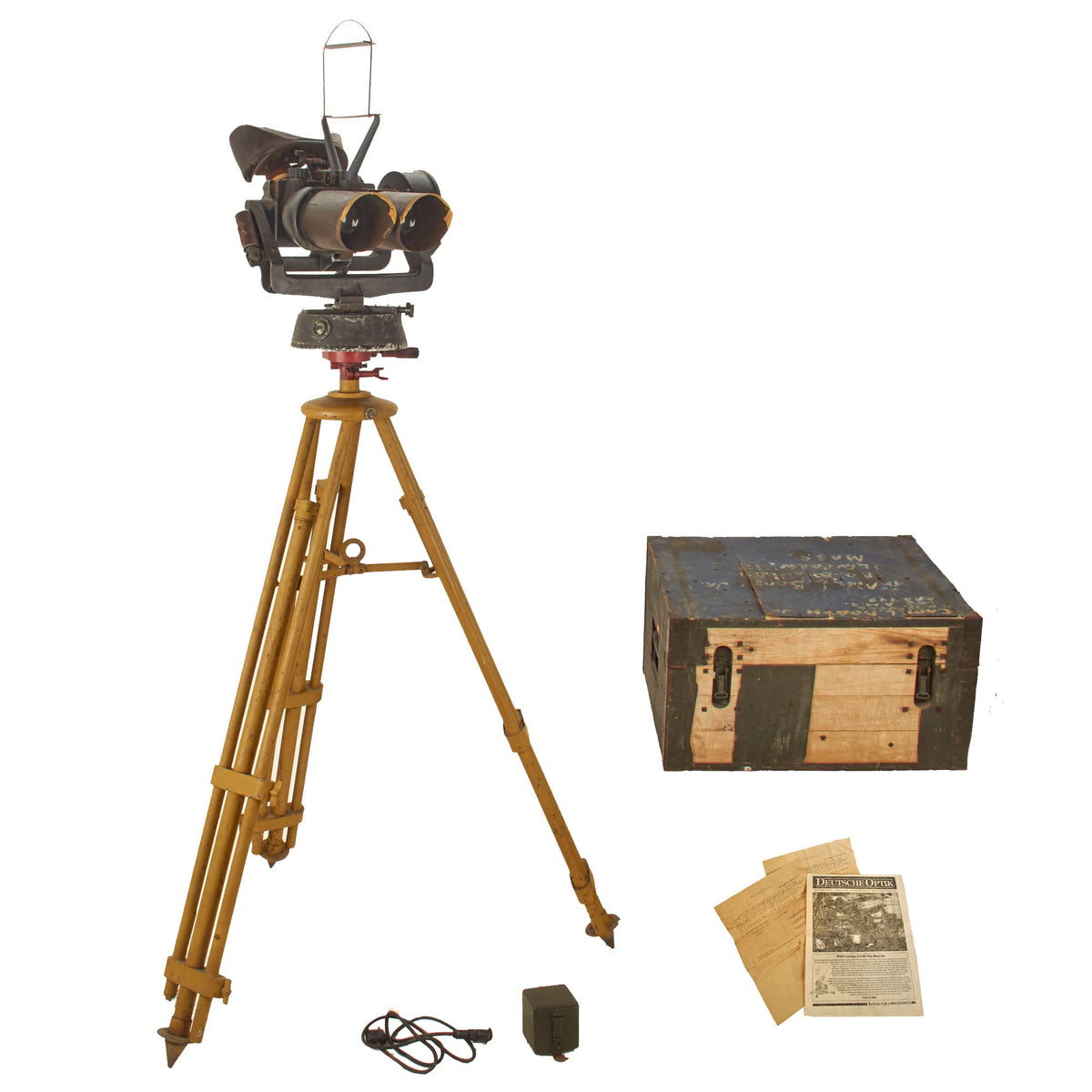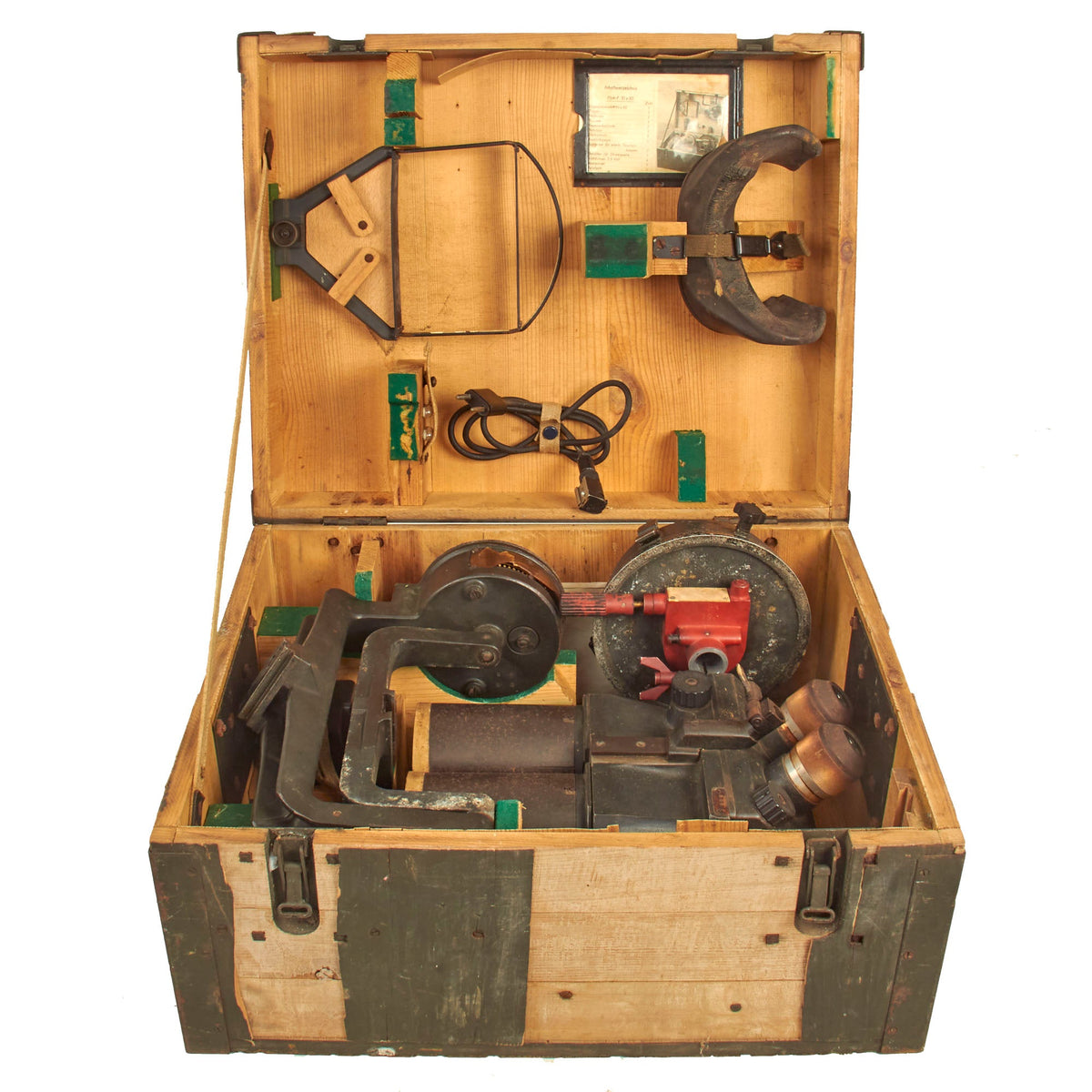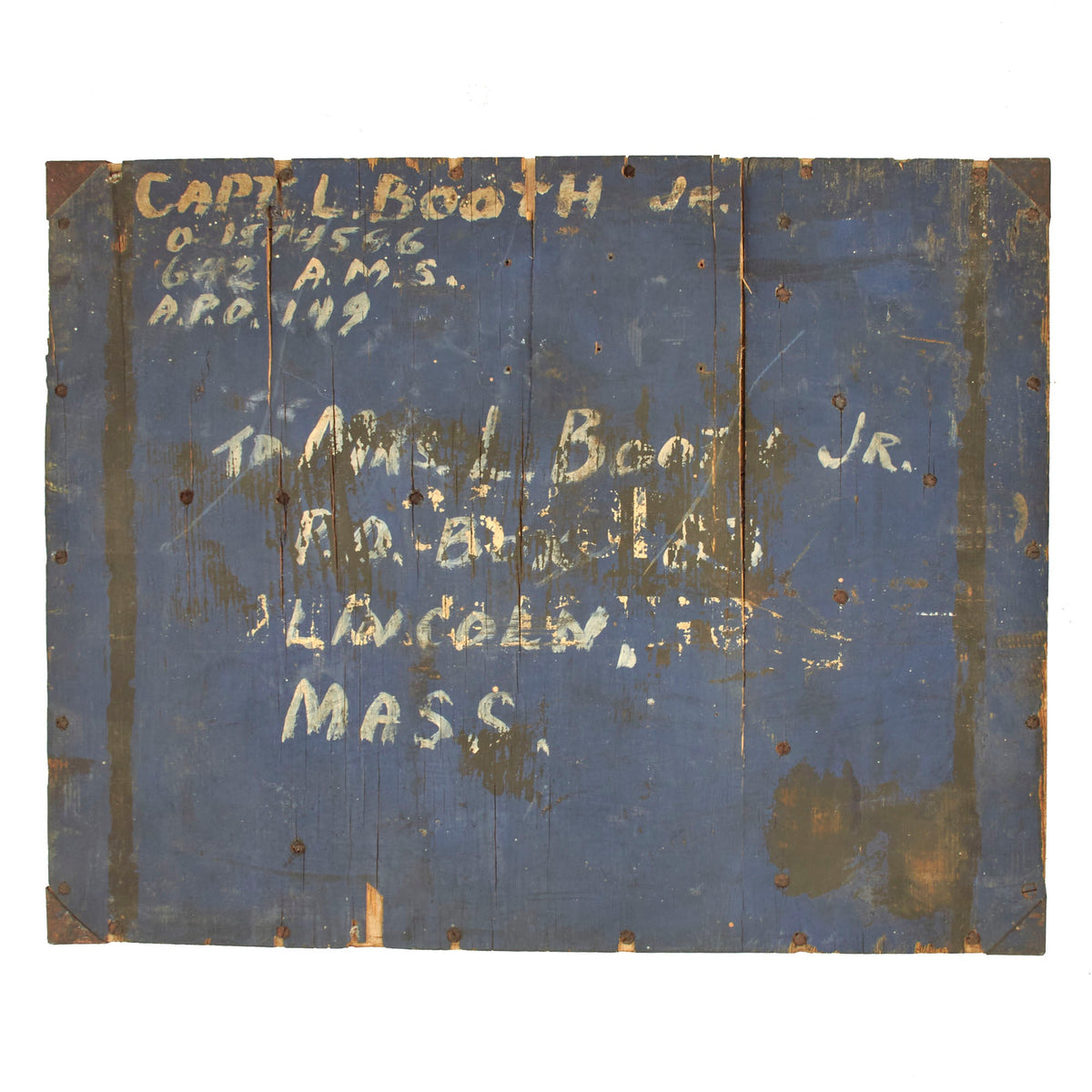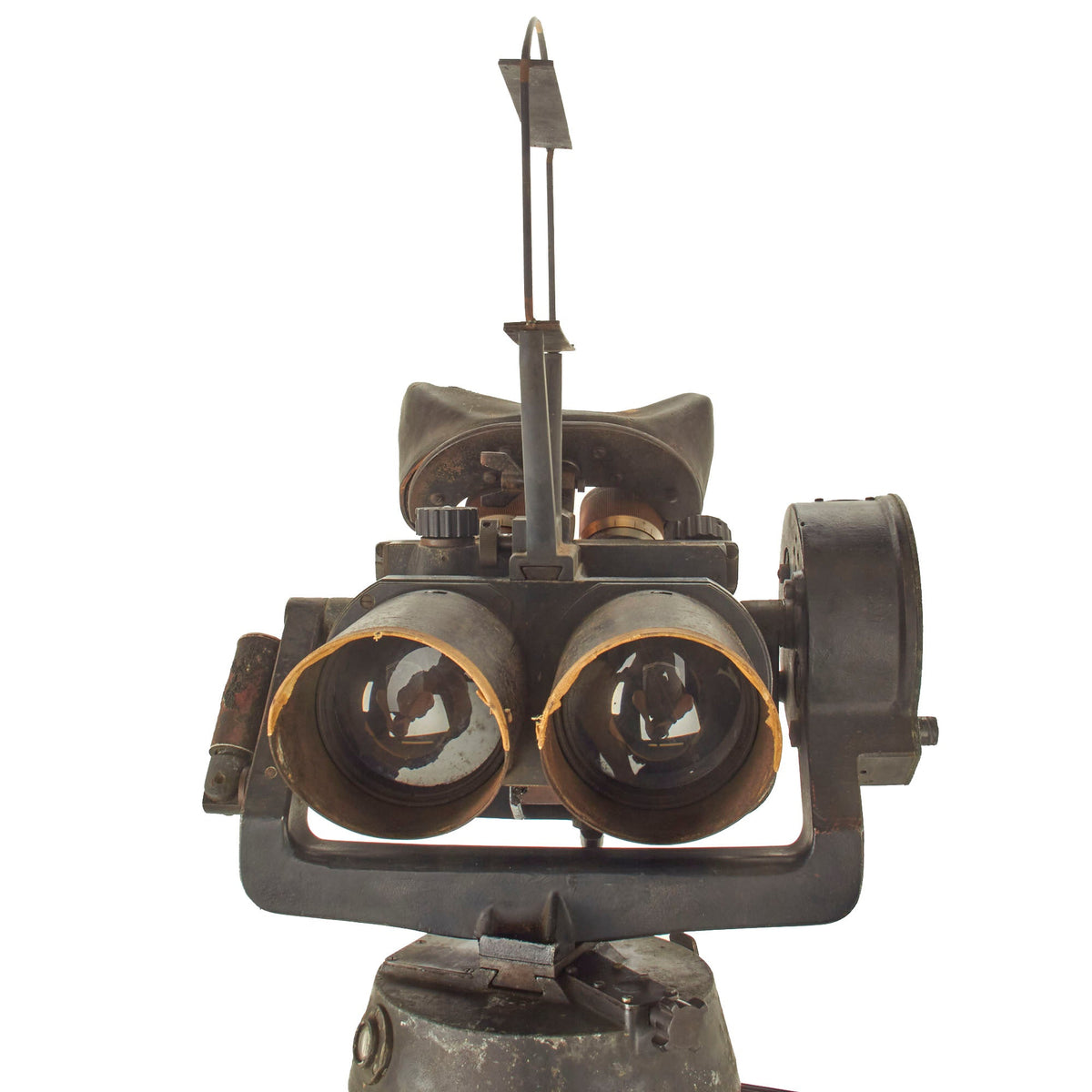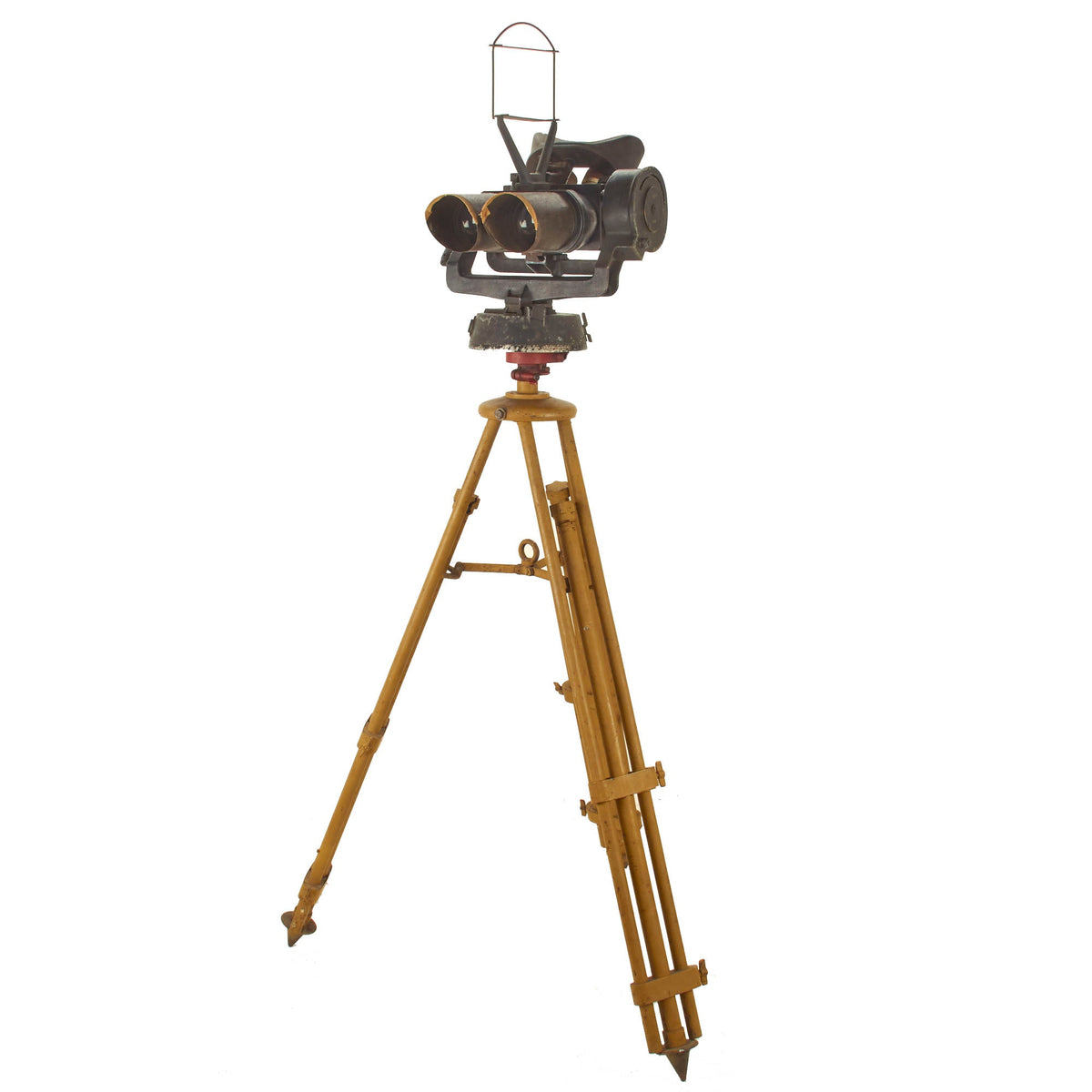Original German WWII Luftwaffe Flak D.F. 10 x 80 Binocular Optic Set with USGI Bring Back Certificates Original Items
$ 3.995,00 $ 998,75
Original Item: Only One Set Available. This is a fantastic pair of German World War Two Doppelfernrohr (double telescope) 10 x 80 German gun sight binoculars (flakfernrohr), as part of the most complete set that we have ever had! These were used for direct sighting on the German Flak 36 (88 mm) Gun and are offered in very good condition. They painted a lovely deep gray blue finish, the typical color for Luftwaffe equipment. There is some wear, so the correct red primer can be seen in areas.
They come complete with the mount cradle, which displays the elevation on the left side as the binoculars are moved. This in turn is attached to the top of the correct azimuth turntable, which allows for precise adjustment of the side to side angle. All of this is mounted on top of the proper tripod, which still has three functional legs, and looks to have intact bubble levels as well. The sight director for the top of the optics as well as the forehead pad are also present, and there is even some documentation and a battery box included in the case. We have never had a more complete set for one of these Luftwaffe Flak optics, and we doubt that we will again!
Even better, this item is a NAMED USGI BRING BACK from WWII! It comes complete with TWO original CERTIFICATE authorizations for bringing back enemy material, both of which are named to Capt. Lloyd Booth Jr. and dated 21 Sept 1945. They both have the proper authorization signatures, and indicate that the items will be mailed back. The first certificate is for 1. Flakfinder set German type w/parts, while the second is for 1. Tripod German Type. It is very rare that we get such great sets as these, all original with some great research potential. We unfortunately have not been able to locate any information on Capt. Booth, and leave that as a great project for whoever purchases this excellent piece.
Most commonly seen being used by the KRIEGSMARINE (German Navy) on Ship Bridges and on Conning Towers of U-Boats, these are the giant 10 x 80 Binoculars so much favored in WW2. The binoculars themselves are in very good condition, and are definitely a great example of the D.F. 10×80, of which we have had several before. There are adjustments for eye relief, width and a selection of various tinted filters, which rotate into place using the control on the left side. The dial is labeled klar (clear), hell (light), mittel (medium), and dunkel (dark). In a typical example of German WW2 era (over)engineering, the control actually controls a mechanism that swings each individual filter in place on both sides simultaneously. A more modest implementation with filters that were fitted over the eye pieces would have probably been more economical. The filters still move correctly, and we did not notice any sticking or sluggishness as we often do.
The Steel Sun Shades are still present and in good condition, and are removable if so desired. This set also includes the original padded head rest/shade, which is still soft, with minimal cracking, though one end has had the bakelite base plate partly break away. It can also be removed, though it can get a bit stuck at times.
The right side of the binocular body is marked:
D.F. 10 X 80
O dkl X
53469
X
“D.F.” Is the abbreviation for Doppelfernrohr (double telescope), with 10 x 80 indicating the magnification power of the optics. The German wartime three letter code dkl stands for Josef Schneider & Co., of Kreuznach, a specialist lens maker, and under that the set’s serial number is given. Wartime serial numbers for this maker range from 5437 up to 82,036, indicating this is a mid war example. The colored symbols on either side of the maker indicate the type of lubricants to be used on the binoculars.
The mount cradle on this example is marked with cll / 2011, while the azimuth adjustment is marked cll / 2932, so both were manufactured by August Baumgart, Feinmechanik und Praezisionsmaschinenbau (Precision mechanics and precision mechanical engineering) in Rathenow, Germany. This is not a matched set by any means, very common for examples that saw long service in the war.
The cradle is functional, however the celluloid cover for the angle reading has yellowed and cracked over time. The azimuth still attaches correctly, however the adjustment knob is broken off, and was attached to the bottom only for the pictures. The delicate aluminum adjustment shaft unfortunately cracked around the pin long ago, and without support it just falls off.
This fantastic set comes in the original transit chest, which still has some of the information inside, and also was even marked on the lid by the soldier who sent it back! It looks like they actually shipped it back in the chest, a real testament to the quality of the manufacture. As best we can tell, the sender address is:
CAPT. L. BOOTH JR.
O 1574596
G42 A.M.S.
A.P.O. 149
The recipient address is:
MRS. L. BOOTH JR.
PO BOX 23
LINCOLN,
MASS.
The blue paint is somewhat worn, and the address along with it, however this also has revealed some of the original German markings, which could possibly be deciphered. Really some fantastic research potential in this set!
The tripod portion of the set is has a Waffenamt inspection mark over a maker code which looks to read “obp” or “bbp, and also bears serial number 14939. It however appears that the maker code is upside-down, and in fact is marked dqc. for Eugen Ising, a metalworking business located in Bergneustadt in Rheinland. This maker has been seen before on MG34 “Music Stand” style tripods. This is exactly the type of maker you would expect for one of these tripods. The tripod is painted tropical dunkelgelb (dark yellow), used in North Africa, Italy, and the Caucuses area during WWII.
This set is fully operational, with partly clear optics, which show some discoloration and haze when you look through them. We assume that they just need a cleaning and servicing, which they probably have not had since WWII. The set has fully functional focus and width adjustments, and the filters move into place easily. The cradle is fully functional as well, though the adjustment is broken off the azimuth, as previously noticed. The leveling adjustments on the tripod legs also appear to be functional. Overall condition of the set is very good, with lovely paint, and some oxidation on the center portion of the tripod legs. We have not made any attempts to clean or service any part of the set to preserve the patina.
A magnificent set, ready to display or even use after a good servicing!
Fast Shipping with Professional Packaging
Thanks to our longstanding association with UPS FedEx DHL, and other major international carriers, we are able to provide a range of shipping options. Our warehouse staff is expertly trained and will wrap your products according to our exact and precise specifications. Prior to shipping, your goods will be thoroughly examined and securely secured. We ship to thousands clients each day across multiple countries. This shows how we're dedicated to be the largest retailer on the internet. Warehouses and distribution centres can be located throughout Europe as well as the USA.
Note: Orders with more than one item will be assigned a processing date depending on the item.
Before shipping before shipping, we'll conduct a thorough inspection of the items you have ordered. Today, the majority of orders will be delivered within 48 hours. The delivery time will be between 3-7 days.
Returns
The stock is dynamic and we cannot completely manage it because multiple stakeholders are involved, including our factory and warehouse. So the actual stock may alter at any time. It's possible that you may not receive your order once the order has been made.
Our policy is valid for a period of 30 days. If you don't receive the product within 30 days, we are not able to issue a refund or an exchange.
You can only return an item if it is unused and in the same state as the day you received it. You must have the item in its original packaging.
Related products
Uncategorized
Uncategorized
Uncategorized
Australian WWII Owen MK1 Machine Carbine SMG Custom Fabricated Replica with Sling Original Items
Uncategorized
Uncategorized
Uncategorized
Band of Brothers ORIGINAL GERMAN WWII Le. F.H. 18 10.5cm ARTILLERY PIECE Original Items
Uncategorized
Uncategorized
Uncategorized
Uncategorized
Uncategorized
Uncategorized
Uncategorized
Uncategorized
Uncategorized
Uncategorized
Uncategorized
